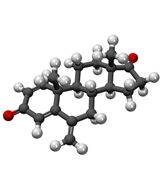Commonly Used Breast Cancer Drug May Have Wider Benefits
Researchers have found that the breast cancer drug exemestane may also protect cells against DNA damage from UV radiation as well as damage that occurs during inflammation and oxidative stress.
Chemical structure of exemestane

The aromatase inhibitor exemestane is widely used to treat women with estrogen-receptor (ER)-positive postmenopausal breast cancer. The drug blocks the activity of the enzyme aromatase that is responsible for the last step in estrogen synthesis, slowing the growth of ER-positive breast tumors that require estrogen for their growth.
Now, in a set of laboratory experiments, researchers at the Johns Hopkins University School of Medicine demonstrate that, unexpectedly, the drug may also protect cells in the body against damage to their DNA by UV radiation and damage that occurs during inflammation and oxidative stress-all unrelated to its role in blocking the estrogen signaling pathway. The study suggests that the benefit of exemestane seen in breast cancer may be more than just its ability to block estrogen production. The results are published in the Proceedings of the National Academy of Sciences.
“Exemestane is potently anti-inflammatory and antioxidant and can thereby protect against development of cancer and chronic degenerative diseases,” conclude the authors. Whether the aromatase inhibitor may be able to be used by a larger population beyond those with breast cancer still needs to be tested, but the study suggests the agent could be used to prevent damage from the onslaught of inflammatory and oxidative damage to different tissue types, in both women and men.
The activity of exemestane was also shown to be synergistic with other protective phytochemicals such as sulforaphane, found in cruciferous vegetables, which could be exploited.
The right drugs and food can turn the cell’s natural protective mechanisms-which may not always be set to “on”-to occur at full capacity, said study author Paul Talalay, MD, a professor of pharmacology and molecular sciences at the Johns Hopkins University School of Medicine, in a statement. The experiments in mouse, rat, and human cells demonstrate that exemestane may have the ability to turn on these protective cell processes.
Exemestane is a synthetic steroid that has a chemical structure similar to agents that have been shown to induce the activity of transcription factors that control antioxidants and other cell-protective proteins, said the authors. This observation led them to test the effects of exemestane on cells in culture.
Adding exemestane to cells in vitro, including mouse skin cells, liver tumor cells, human retina cells, and rat heart cells, Hua Liu, lead author of the publication, showed that the drug boosts a spectrum of cytoprotective enzymes in these cells. Similar experiments with other estrogen-targeted agents, tamoxifen and letrozole, did not have the same effect.
Exemestane was shown to protect against oxidation activity, hypoxia, damage from UV radiation, and also displayed anti-inflammatory properties similar to that of sulforaphane. The combination of the two agents was more potent than each alone, although the mechanism for this synergy remains to be explored.